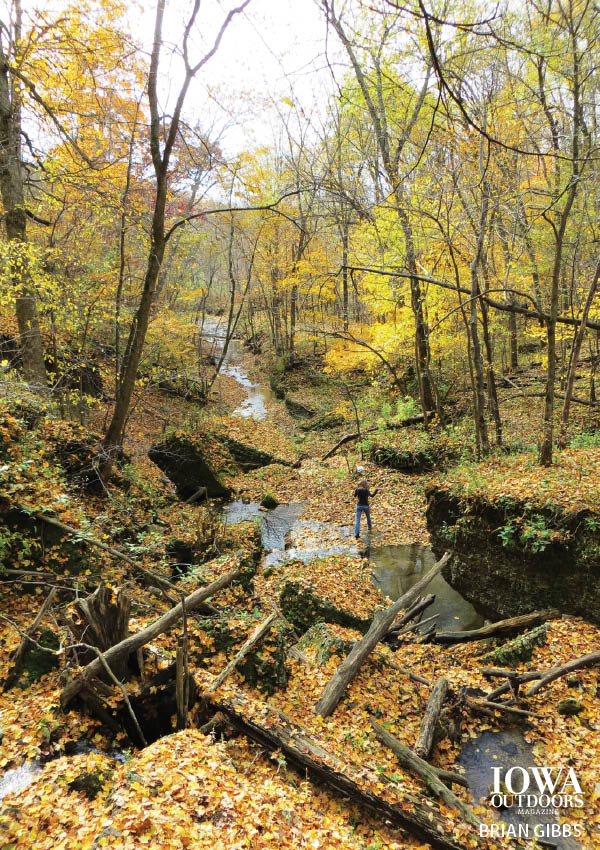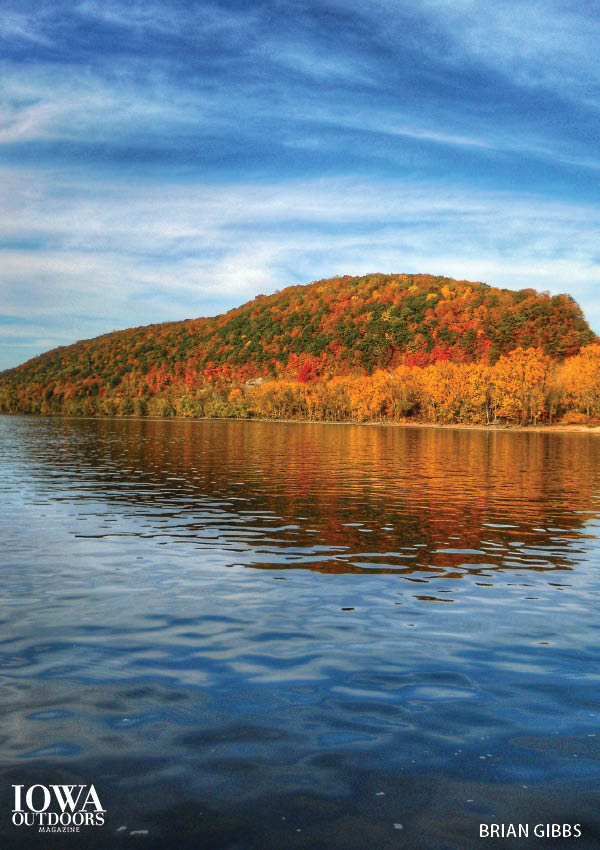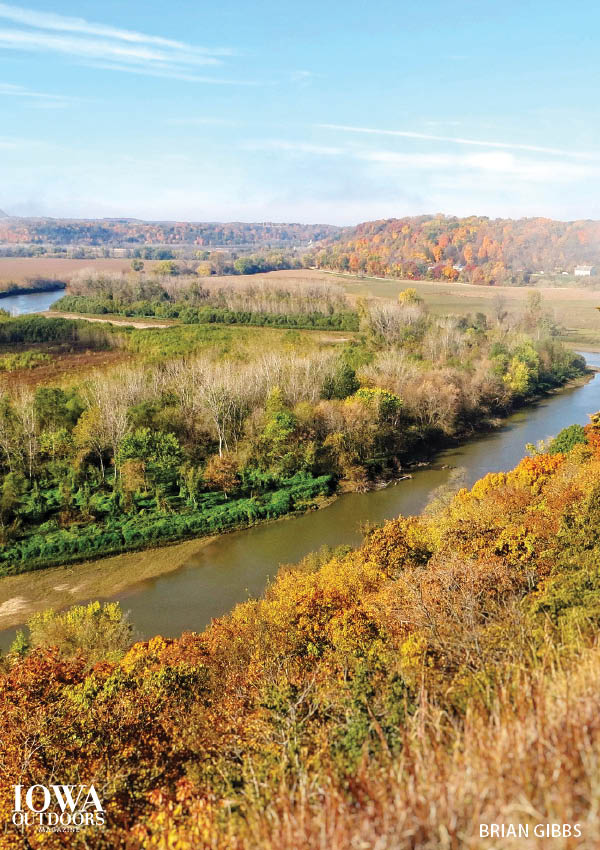Story and photos by Brian Gibbs
From the September/October 2016 issue of Iowa Outdoors magazine
Subscribe now
 Far up in the northeast corner of Iowa lies a tiny gem of a town called Marquette. The town proudly proclaims to be “Iowa’s Best Kept Secret.” In fact, if it wasn’t for the congenial welcome sign that reads “The People of Iowa Welcome You. Iowa: Fields of Opportunities,” most Iowans would never know they were still in the Hawkeye State. Yet, in this area of Iowa, the sign almost seems like a misnomer as there are few fields to see.
Far up in the northeast corner of Iowa lies a tiny gem of a town called Marquette. The town proudly proclaims to be “Iowa’s Best Kept Secret.” In fact, if it wasn’t for the congenial welcome sign that reads “The People of Iowa Welcome You. Iowa: Fields of Opportunities,” most Iowans would never know they were still in the Hawkeye State. Yet, in this area of Iowa, the sign almost seems like a misnomer as there are few fields to see.
Marquette resides on the corner of what is called the Driftless Area. The driftless is an ancient landscape characterized by its rugged topography, caves, sinkholes, springs and other unique geological features absent in the rest of Iowa. The term “driftless” applies to the general lack of “glacial drift” or glacial sediments in the area. Geologists estimate it has been nearly 500,000 years since the last glacier covered this area. For perspective, it was a mere 12,000 years ago when the last ice sheet in north-central Iowa retreated and formed the Des Moines Lobe.
The long absence of these ice bulldozers in far northeast Iowa has allowed the power of moving water to down-cut through softer underlying rocks, resulting in steep slopes that form gorges, canyons and deeply dissected v-shaped river valleys that turn legendary in the fall, which is the best time to discover why this area of the state is Iowa’s best kept secret.
Every fall, I replay a driftless dream where I’m lost in the far reaches of a cathartic valley of autumn light. Beauty is trembling in the gold incandescence of zebra-barked aspens. Peace lingers in the russets and auburns of grizzled bur oaks. The kaleidoscopes of leaf color keep me awake to the contour of this landscape that is undulating like the flight of a flicker, pulsating like a cold-water spring. I dream out loud where spawning brown trout lay calmly with their bellies on their redds. Several eagles are perched downstream on veneer walnut trees. In the late tangerine sundown, tiny bubbles rise from the stream bottom, and, as I walk closer, two otters surface.
One of the otters swims within 15 feet of me, wafts, then dives underwater, only to rise again with a fish in its mouth. I try to capture the animal with a photograph, but am distracted by the whoosh of an eagle flying above. Continuing further downstream, brown trout and smallmouth bass swim at my feet until a crescent moon rises over the eastern bluff. The shadows of this canyon embrace the leaves that glow like red lanterns. The big trees always guide me back home. In the driftless, my dreams are as unique as these trees that grow from rocks.
 Where there are rocks, there are trees.
Where there are rocks, there are trees.
To learn more about the uniqueness of driftless forests, I tagged alongside DNR forester Bruce Blair. For the past two decades, Blair was district forester of the region before recently becoming forester at Yellow River State Forest.
As we walk through the forest, Blair points out several plant species growing on the forest floor and explains the forests of the driftless are unique in their soil composition. “The soil in the driftless is mostly silty loam in origin and is some of the richest soil in the world. The trees growing here have the audacity to try and grow on some of the richest farmland in the world,” he explains.
Blair continues on with a discussion about climate—far northeast Iowa is an area that is more dominated by moisture coming up from the gulf as opposed to drier air out west that fosters prairie development. “Ultimately, many of the trees in the driftless are growing on lands too steep, rocky or wet to farm,” concludes Blair.
At times during our amble, I feel like I’m walking on a sponge. The soil is extremely rich in thick layers of humus and the steep slopes of various aspects in this forest create a variety of micro-habitats that add up to an incredibly biologically diverse ecosystem. Eventually, we end in bottomland forest where a spring cascades from the rocks and a giant walnut tree towers overhead. I ask Blair if it is the tallest walnut he has seen. Giddily, he responds with a magical story of a 130-foot tall walnut tree growing by Marquette that is valued at nearly $20,000. “The driftless grows the best walnut in the entire world,” exclaims Blair with a smile.
So what will the future hold for forests of the driftless? Blair describes a theory called habitat typing, coined by University of Wisconsin professor John Kotar. Kotar used the understory herbaceous vegetation as an indicator of the natural forest that a site wants to move toward. “Under his classification system, he calls most of northeast Iowa “Acer-Tilia-Desmodium,” which means maple-basswood-pointed leaf tick trefoil. According to his understory plant indicators, most of northeast Iowa wants to become a maple-basswood forest type. It was only because Native Americans constantly tended the land, using fire as a tool, that we have all this abundance of oak-hickory forest the past several centuries,” says Blair.
Without fire or some type of disturbance, the forests of northeast Iowa will continue their path of natural succession. Low-intensity fires, barely knee high, kept the forest understory open, allowing more light to reach the forest floor to help young oak trees reach skyward. I can’t help but wonder, what did these forests look like thousands of years ago?
A fascinating University of Iowa study led by Dr. Richard Baker in the 1990s involved the collection of pollen and plant fossils from the Roberts Creek streambed in Clayton County. Study results suggest that from 9,000 to 13,000 years ago, the driftless area was largely a boreal forest dominated by pine and larch trees with populations of poplar and elms scattered in.
Mixed hardwood trees and willows slowly replaced coniferous trees until the tallgrass prairie established its roots into the driftless soil from 2,500-5,500 years ago. Yet, due to its rugged topography and moist gulf weather patterns, the far corner of northeast Iowa never fully transitioned into a sea of tall-grass prairie. Today in the region, many private landowners do their part to ensure area oak-hickory forests will be around for generations to come.
 An Act of Stewardship
An Act of Stewardship
In 1906, the Iowa Legislature approved a landowner property tax incentive known as the Forest and Fruit Tree Reservation Act to “reduce or eliminate property taxes to induce landowners to hold their poorer lands in timber not only as a source of farm income but also for erosion control, watershed protection and game cover.” Today, this act is more commonly referred to as Iowa’s Forest Reserve Program.
In 2014, Clayton and Allamakee counties ranked first and second with a combined enrolled 94,573 acres in forest reserve. To qualify, a few simple requirements must be met, including but not limited to: the timber must be greater than 66 feet wide, more than 2 acres in size and cattle must be kept out. The incentive for private landowners who put their land in forest reserve is tremendous and cannot be underestimated. Not only are forest reserve acres tax exempt, they also conserve areas of biological diversity, protect water quality, add timber value and promote the scenic beauty of fall color.
So just what makes all this beautiful color?
The primary force driving the color change is a decreasing amount of sunlight in autumn. Shorter days and cooler nights signal a change in the leaf’s biology and the fall mosaic of color begins to appear. As this change starts to take place, a few biological artists commence their work behind the scenes.
Chlorophyll is the compound that gives tree leaves their green color and is essential for photosynthesis. As the fall season grows near, trees produce very little chlorophyll, causing the green color to fade away. Another important element affecting leaf color are carotenoids—pigments responsible for producing yellow, brown and orange colors in leaf cells. In spring and summer these hues are masked by the green chlorophyll.
Lastly, as cool weather arrives, anthocyanins start to be produced in the leaf cells. Anthocyanins are pigments responsible for blue, red and purple colors. In foods such as blueberries and raspberries, anthocyanins are what give color to these tasty fruits. In trees, these pigments are produced primarily in the autumn and add the most vibrant colors to fall leaves.
How they all work together
As the growing season ends in late summer, chlorophyll in the trees is mostly removed. The removal of chlorophyll allows the carotenoids and recently produced anthocyanins to show their true colors. The best set of circumstances for producing fall colors is to have clear cool sunny days and cool nights without freezing temperatures. In the driftless, the most opportune time to view the medley of fall colors is typically around Oct. 10.
Easiest places to view fall color in the Driftless
Travel the Great River Road in Guttenberg north to historic Pikes Peak State Park in McGregor. At the park, witness some of the most striking views of the Upper Mississippi, the highlight being Pikes Peak Overlook. From this vantage, 500 feet above the Mighty Mississippi, you stand in the location where French explorers Marquette and Joliet first saw Iowa from the mouth of the Wisconsin River on June 17, 1674. These two explorers were tasked with finding the “great water” that emptied into the sea and were credited with being the first Europeans to see Iowa.
The DNR’s Pikes Peak park manager, Matt Tschirgi, says one of his favorite parts of fall in the park is “seeing the reactions of friends and park visitors and the looks on their faces when they see the colors for the first time from one of the park’s overlooks.” Besides watching the fall color transition, Tschirgi enjoys witnessing the migration of waterfowl on the Upper Mississippi.
After Pikes Peak, take Highway 76 and travel the Driftess Area Scenic Byway into Yellow River State Forest. The 5,237-acre Paint Creek Unit has two trout streams that flow tranquilly through the park, and several gravel roads lead to scenic vistas including Larkin, Big Paint, Little Paint and Cedar overlooks.
Venture the narrow fire tower road up to the state’s only fire tower. Raised in 1962, the 100-foot unstaffed fire tower stands 1,047 feet above sea level. After touring Yellow River State Forest, take the Driftless Byway four miles north of Harpers Ferry until you arrive at Red Oak Road.
From Red Oak Road, enjoy uninterrupted views of the Mississippi River and dozens of migrating waterfowl resting in the shallow bays. Later in the fall, thousands of tundra swans congregate here before making their fascinating migration east to the Chesapeake Bay. Bald eagles frequently can be seen directly in the tree branches above the road.
For more excellent fall foliage and eagle viewing opportunities, take Chariot Road north of Elkader, which offers views of splendid bluff-side color while traveling alongside the beautiful Turkey River. This route allows the visitor to get a close view of two active eagle nests. According to DNR wildlife diversity biologist Stephanie Shepard, Clayton County ranks second with 70 eagle nests; Allamakee is first with 136. These numbers are even more staggering given that the once widespread use of DDT in the mid-20th century resulted in Allamakee containing the only active eagle nest in Iowa during 1974.
In the driftless, visitors experience a land long untouched by glaciers and feel a native landscape that still has an intact, wild heartbeat. The colors of the driftless are the legends for which Iowa should be remembered. The driftless, Iowa’s last best place.